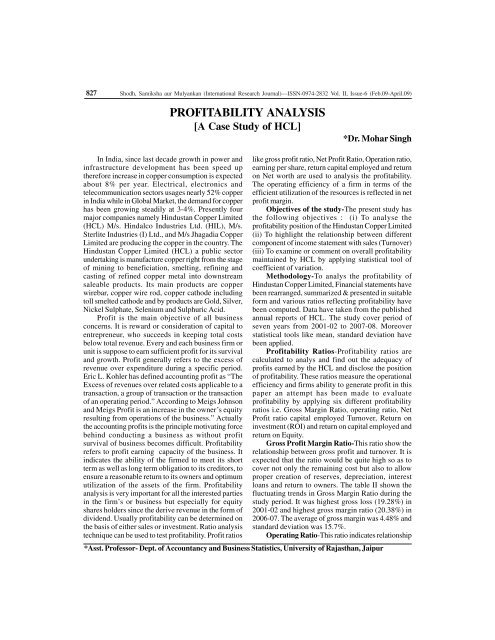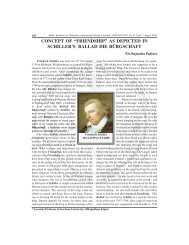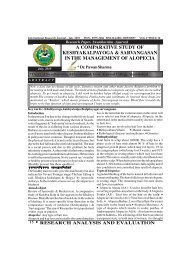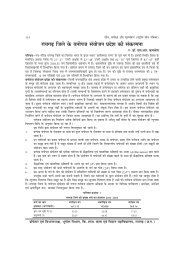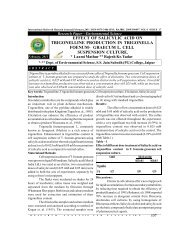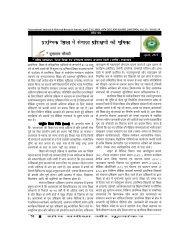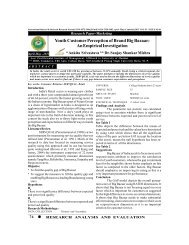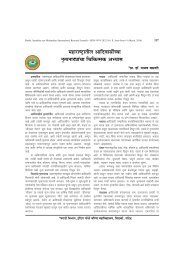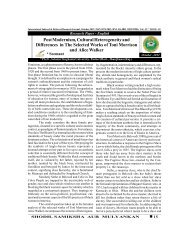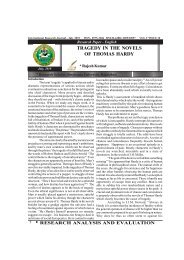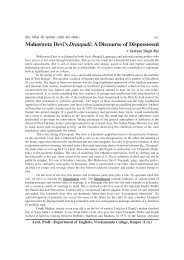Shodh, Samiksha aur Mulyankan - international indexed refereed ...
Shodh, Samiksha aur Mulyankan - international indexed refereed ...
Shodh, Samiksha aur Mulyankan - international indexed refereed ...
Create successful ePaper yourself
Turn your PDF publications into a flip-book with our unique Google optimized e-Paper software.
827 <strong>Shodh</strong>, <strong>Samiksha</strong> <strong>aur</strong> <strong>Mulyankan</strong> (International Research Journal)—ISSN-0974-2832 Vol. II, Issue-6 (Feb.09-April.09)<br />
PROFITABILITY ANALYSIS<br />
[A Case Study of HCL]<br />
*Dr. Mohar Singh<br />
In India, since last decade growth in power and<br />
infrastructure development has been speed up<br />
therefore increase in copper consumption is expected<br />
about 8% per year. Electrical, electronics and<br />
telecommunication sectors usages nearly 52% copper<br />
in India while in Global Market, the demand for copper<br />
has been growing steadily at 3-4%. Presently four<br />
major companies namely Hindustan Copper Limited<br />
(HCL) M/s. Hindalco Industries Ltd. (HIL), M/s.<br />
Sterlite Industries (I) Ltd., and M/s Jhagadia Copper<br />
Limited are producing the copper in the country. The<br />
Hindustan Copper Limited (HCL) a public sector<br />
undertaking is manufacture copper right from the stage<br />
of mining to beneficiation, smelting, refining and<br />
casting of refined copper metal into downstream<br />
saleable products. Its main products are copper<br />
wirebar, copper wire rod, copper cathode including<br />
toll smelted cathode and by products are Gold, Silver,<br />
Nickel Sulphate, Selenium and Sulphuric Acid.<br />
Profit is the main objective of all business<br />
concerns. It is reward or consideration of capital to<br />
entrepreneur, who succeeds in keeping total costs<br />
below total revenue. Every and each business firm or<br />
unit is suppose to earn sufficient profit for its survival<br />
and growth. Profit generally refers to the excess of<br />
revenue over expenditure during a specific period.<br />
Eric L. Kohler has defined accounting profit as “The<br />
Excess of revenues over related costs applicable to a<br />
transaction, a group of transaction or the transaction<br />
of an operating period.” According to Meigs Johnson<br />
and Meigs Profit is an increase in the owner’s equity<br />
resulting from operations of the business.” Actually<br />
the accounting profits is the principle motivating force<br />
behind conducting a business as without profit<br />
survival of business becomes difficult. Profitability<br />
refers to profit earning capacity of the business. It<br />
indicates the ability of the firmed to meet its short<br />
term as well as long term obligation to its creditors, to<br />
ensure a reasonable return to its owners and optimum<br />
utilization of the assets of the firm. Profitability<br />
analysis is very important for all the interested parties<br />
in the firm’s or business but especially for equity<br />
shares holders since the derive revenue in the form of<br />
dividend. Usually profitability can be determined on<br />
the basis of either sales or investment. Ratio analysis<br />
technique can be used to test profitability. Profit ratios<br />
like gross profit ratio, Net Profit Ratio, Operation ratio,<br />
earning per share, return capital employed and return<br />
on Net worth are used to analysis the profitability.<br />
The operating efficiency of a firm in terms of the<br />
efficient utilization of the resources is reflected in net<br />
profit margin.<br />
Objectives of the study-The present study has<br />
the following objectives : (i) To analyse the<br />
profitability position of the Hindustan Copper Limited<br />
(ii) To highlight the relationship between different<br />
component of income statement with sales (Turnover)<br />
(iii) To examine or comment on overall profitability<br />
maintained by HCL by applying statistical tool of<br />
coefficient of variation.<br />
Methodology-To analys the profitability of<br />
Hindustan Copper Limited, Financial statements have<br />
been rearranged, summarized & presented in suitable<br />
form and various ratios reflecting profitability have<br />
been computed. Data have taken from the published<br />
annual reports of HCL. The study cover period of<br />
seven years from 2001-02 to 2007-08. Moreover<br />
statistical tools like mean, standard deviation have<br />
been applied.<br />
Profitability Ratios-Profitability ratios are<br />
calculated to analys and find out the adequacy of<br />
profits earned by the HCL and disclose the position<br />
of profitability. These ratios measure the operational<br />
efficiency and firms ability to generate profit in this<br />
paper an attempt has been made to evaluate<br />
profitability by applying six different profitability<br />
ratios i.e. Gross Margin Ratio, operating ratio, Net<br />
Profit ratio capital employed Turnover, Return on<br />
investment (ROI) and return on capital employed and<br />
return on Equity.<br />
Gross Profit Margin Ratio-This ratio show the<br />
relationship between gross profit and turnover. It is<br />
expected that the ratio would be quite high so as to<br />
cover not only the remaining cost but also to allow<br />
proper creation of reserves, depreciation, interest<br />
loans and return to owners. The table II shown the<br />
fluctuating trends in Gross Margin Ratio during the<br />
study period. It was highest gross loss (19.28%) in<br />
2001-02 and highest gross margin ratio (20.38%) in<br />
2006-07. The average of gross margin was 4.48% and<br />
standard deviation was 15.7%.<br />
Operating Ratio-This ratio indicates relationship<br />
*Asst. Professor- Dept. of Accountancy and Business Statistics, University of Rajasthan, Jaipur
‡ÊÊappleœ, ‚◊ˡÊÊ •ÊÒ⁄U ◊ÍÀÿÊ¢∑§Ÿ (•ãÃ⁄U⁄UÊCÔ˛UËÿ ‡ÊÊappleœ ¬ÁòÊ∑§Ê)—ISSN-0974-2832,Vol. II, Issue-6 (Feb.09-April.09) 828<br />
between operating cost and net sales. It is expected<br />
to lower ratio so that non operating cost, payment of<br />
dividend and creating of reserve can be covered<br />
against operating profit. Lower operating ratio mean<br />
higher the operating profit ratio. In case of HCL it<br />
was more than 100% during the year 2001-02 and 2002-<br />
03 which indicates operating loss instead of profit.<br />
The average of ratio as 95-36% which can be said to<br />
much higher. The standard deviation was equals to<br />
the deviation of gross margin i.e. 15.7%.<br />
Net Profit Ratio: This ratio indicate the<br />
relationship between Net Profit and Net Sales. This<br />
ratio determine the efficiency of business concern.<br />
Higher net profit ratio reflect efficient & proper<br />
utilization of resources of the firm and provide<br />
safeguard to owner’s fund. According to Table II,<br />
Net Profit ratio was Negative upto 2003-04 (-10.82%)<br />
which can be said unsatisfactory. The higher net profit<br />
Ratio (17.44%) was in 2006-07 and average of the ratios<br />
was -3.24%. It is concluded that HCL profitability<br />
position is not satisfactory.<br />
Capital Employed , ROI and Return on equity-<br />
Similarly in case of other ratios like capital employed<br />
turnover, return on investment and return on equity<br />
the fluctuating trends has been shown by the table.<br />
The average of return on investment was 18.52% while<br />
return on equity average was negative i.e. 1-80%. The<br />
standard deviation were 48.47% and 21.89%<br />
respectively. ROI present the relationship between<br />
margin before tax and investment therefore it is overall<br />
profitability measurement ratio. In case of the<br />
Hindustan Copper Limited it was highest in the year<br />
2006-07 (72.76%) and lowest in 2001-02 (-46.78%). The<br />
most important factor that effects the company’s<br />
turnover & managing were fluctuation in foreign<br />
exchange rate and Amortisation & Depreciation as<br />
indicates by the table I. Steps should be taken to<br />
reduce non-operating expenses.<br />
References-<br />
1. Anderson, E.W., Fornell, C. and Lehmann, D.R. (1994) “ Customer Satisfaction, market Research and Profitability:<br />
Finding from Sweden” Journal & Marketing Research 58 (July) 53-66<br />
2. Ghosh. D (2005) “Alternative measures of managers performances, control ability and the outcome Effect” Behavioral<br />
Research in Accounting 17 55-70<br />
3. Biddle G.C.S. Bowen, R.M., and Wallole, J.S. (1998) “ Does EVA BEAT Earnings Evidence on the Association with<br />
stock Returns and Financial Values “ Journal of Accounting and Economics 24 Page 301-36.<br />
4. Eric L Kohler “A dictionary for Accountants” Prentice Hall of India Pvt. Ltd. New Delhi<br />
5. Walter B. Meigs, Charles E. Johns and Rober F. Meigs” Accounting the basis for Business decisions” Mc Grrow with Book<br />
Co. New York.<br />
6. My-Khan and P.K. Jain “Management Accounting” Text Problems and Cases (2007) TATA MCGRAW Hill Publishing<br />
Company Ltd. New Delhi<br />
7. Weston, F. “Prepare for the financial Accounting Revolution” Harvard Business Review (1974)<br />
8. Pandey I.M. “Financial Management (2008) Vikash Publishing House Pvt. Ltd.<br />
9. Alnoor Bhimani “ Contemporary Issues in Management Accounting” (2006) Oxford University Press Inc. New York.


